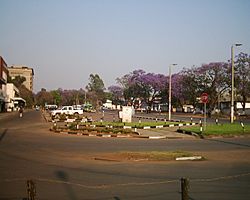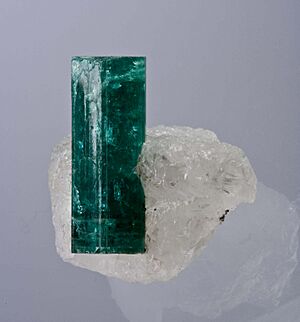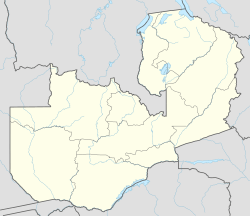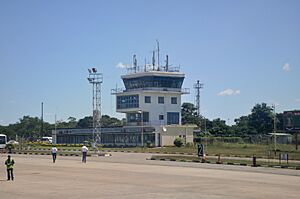Ndola facts for kids
Quick facts for kids
Ndola
|
|
|---|---|
|
City
|
|

Downtown Ndola
|
|
| Nickname(s):
NoliNoli
|
|
| Country | |
| Province | Copperbelt Province |
| District | Ndola District |
| Inception | 1904 |
| Elevation | 1,300 m (4,300 ft) |
| Population
(2022)
|
|
| • Total | 627,503 |
| Demonym(s) | Zimandola |
| Time zone | UTC+2 (CAT) |
| Climate | Cwa |
Ndola is the third largest city in Zambia by size and population. In 2022, about 627,503 people lived there. It is smaller than the capital city, Lusaka, and Kitwe. However, it is the second largest in terms of buildings and services after Lusaka. Ndola is a major industrial and commercial hub in the Copperbelt region of Zambia. This area is famous for copper mining. Ndola is also the capital of Copperbelt Province. It is located only 10 kilometers from the border with the DR Congo. The city is home to Zambia's first modern sports stadium, the Levy Mwanawasa Stadium.
Contents
History of Ndola
The area where Ndola is today was first settled by the Lamba people. They were led by Senior Chief Chiwala. The Lamba people moved here from the Luba-Lunda kingdom around the year 1600. The name Ndola comes from a river that starts in the Kaloko Hills and flows into the Kafubu River.
The town of Ndola was officially started in 1904 by John Edward "Chiripula" Stephenson. It began as a boma, which was a government office, and a trading post. This helped it grow into the important administrative and trading center it is today.
The main Rhodesia Railways train line reached Ndola in 1907. This allowed people to travel by train as far south as Bulawayo. From there, they could connect to Cape Town. The train line was later extended into the DR Congo. Eventually, it connected to the Benguela Railway. This railway goes to the Atlantic port of Lobito. For many years, some of Zambia's copper was sent out through this port. Ndola became a key distribution center for the country because of this railway. Before good roads were built in the 1930s, a path from Ndola to Kapalala on the Luapula River was used. Then, boats carried goods from there to the Chambeshi River. This was the main trade route for the Northern Province.
In 1961, a plane carrying important United Nations leaders crashed near Ndola. One of the people who died was Dag Hammarskjöld, the second Secretary-General of the United Nations.
Ndola's Climate
Ndola has a moderate humid subtropical climate. This means it has warm, humid summers and mild winters.
| Climate data for Ndola (1991–2020, extremes 1961–2020) | |||||||||||||
|---|---|---|---|---|---|---|---|---|---|---|---|---|---|
| Month | Jan | Feb | Mar | Apr | May | Jun | Jul | Aug | Sep | Oct | Nov | Dec | Year |
| Record high °C (°F) | 34.2 (93.6) |
33.1 (91.6) |
32.0 (89.6) |
32.4 (90.3) |
32.0 (89.6) |
30.7 (87.3) |
31.1 (88.0) |
34.1 (93.4) |
39.6 (103.3) |
36.9 (98.4) |
38.5 (101.3) |
34.5 (94.1) |
39.6 (103.3) |
| Mean daily maximum °C (°F) | 27.6 (81.7) |
27.8 (82.0) |
28.3 (82.9) |
28.3 (82.9) |
27.7 (81.9) |
26.1 (79.0) |
25.8 (78.4) |
28.6 (83.5) |
31.6 (88.9) |
32.7 (90.9) |
30.7 (87.3) |
28.3 (82.9) |
28.6 (83.5) |
| Daily mean °C (°F) | 22.5 (72.5) |
22.5 (72.5) |
22.3 (72.1) |
20.8 (69.4) |
18.4 (65.1) |
16.4 (61.5) |
16.0 (60.8) |
18.8 (65.8) |
22.2 (72.0) |
24.5 (76.1) |
24.1 (75.4) |
22.9 (73.2) |
20.9 (69.6) |
| Mean daily minimum °C (°F) | 17.3 (63.1) |
17.1 (62.8) |
16.3 (61.3) |
13.2 (55.8) |
9.1 (48.4) |
6.6 (43.9) |
6.1 (43.0) |
8.9 (48.0) |
12.8 (55.0) |
16.2 (61.2) |
17.5 (63.5) |
17.5 (63.5) |
13.2 (55.8) |
| Record low °C (°F) | 11.0 (51.8) |
10.6 (51.1) |
7.5 (45.5) |
6.2 (43.2) |
0.5 (32.9) |
−0.9 (30.4) |
0.2 (32.4) |
0.8 (33.4) |
4.0 (39.2) |
6.5 (43.7) |
10.2 (50.4) |
11.2 (52.2) |
−0.9 (30.4) |
| Average precipitation mm (inches) | 301.4 (11.87) |
236.0 (9.29) |
169.6 (6.68) |
26.0 (1.02) |
3.3 (0.13) |
0.1 (0.00) |
0.3 (0.01) |
0.0 (0.0) |
1.6 (0.06) |
18.5 (0.73) |
107.8 (4.24) |
262.9 (10.35) |
1,127.5 (44.39) |
| Average relative humidity (%) | 82.5 | 83.0 | 79.7 | 73.4 | 65.9 | 61.1 | 54.6 | 46.6 | 40.9 | 47.3 | 64.9 | 80.4 | 65.0 |
| Mean monthly sunshine hours | 151.9 | 142.8 | 192.2 | 243.0 | 279.0 | 276.0 | 297.6 | 297.6 | 279.0 | 269.7 | 207.0 | 158.1 | 2,793.9 |
| Source: NOAA (humidity and sun 1961–1990) | |||||||||||||
Population Growth
Ndola's population has grown a lot over the years. Here's how it has changed:
| Census | Population |
|---|---|
| 1990 | 329,228 |
| 2000 | 374,757 |
| 2010 | 451,246 |
| 2022 | 627,503 |
Industries in Ndola

Ndola was once the biggest industrial center in Zambia. It had many large factories, like a Land Rover vehicle assembly plant and factories for Dunlop Tires, Johnson & Johnson, and Unilever. However, between 1980 and 2000, Ndola's economy became much smaller. Many factories closed down. Some industries, like clothing and car assembly, completely disappeared. While Ndola is no longer a "ghost town," it is still working to get back its economic strength from before the 1980s.
Copper and Oil Refining
There are no mines right in Ndola. But the Bwana Mkubwa open-pit mine is only 10 kilometers away. In the past, copper and other valuable metals from other parts of the Copperbelt were brought to Ndola. They were processed at the Ndola Copper Refinery and Precious Metals Refinery. Copper is very important to Zambia's economy. It makes up 70–80% of the country's export earnings.
The Indeni Oil Refinery in Ndola provides refined petroleum for the whole country. It was fixed in 2001 after a big fire in 1999. A company called GL Africa Energy also helps power Zambia. Its Ndola Energy Company Limited provides 105 megawatts of electricity to the national power grid. This power is made from heavy fuel oil from the Indeni Petroleum refinery.
Commercial Businesses
Ndola is home to one of Zambia's national newspapers, the Times of Zambia. It also has its printing company, Printpak. These two operate as one company called TimesPrintpak. A printing press run by the Catholic church, Mission Press, is also in Ndola. Mission Press also works as a commercial business.
Limestone Production
Ndola has huge amounts of limestone. These reserves are thought to be some of the best in the world. Because of this, limestone is as important to Ndola's economy as copper is to the rest of Zambia. It provides a lot of wealth and jobs. Limestone is a main ingredient in making cement. A cement plant uses a lot of limestone to make cement.
From 1974 to 2009, Ndola produced over half of Zambia's cement. This was done at a plant about 5 kilometers southeast of the city center. This plant was called Chilanga Cement, Ndola Works. In 2008, a new company, Lafarge Cement Zambia, built a new plant in Chilanga. This new plant could produce twice as much cement as the Ndola plant. Even with the new plant, Ndola is still very important for cement production in the region. The large limestone deposits and good transport links make Ndola a great place for cement businesses.
Another cement factory was being built in 2008. In 2009, advertisements were put out to hire staff for this new plant.
Another important factory that uses limestone in the area is Ndola Lime. It is the only company in Zambia that produces lime. Ndola Lime is located near the two cement factories. It supplies lime to the mining industry and to farmers who need agricultural lime. Ndola Lime company is owned by ZCCM Investment Holdings. This is a government-owned company that helps manage Zambia's mining and heavy industries.
Local Community and Industry
The factories that process limestone and copper (the cement plants, the lime plant, and Bwana Mkubwa) have mining rights on land very close to the traditional area of Chief Chiwala. Because of this, Chief Chiwala is an important person who has a say in Ndola's industry and economy.
Electrical Engineering
An Egyptian company called Elsewedy Electric teamed up with local Zambian companies in 2008. They worked with ZESCO Ltd, which is Zambia's electricity supply company. Together, they built a factory to make transformers and another to make electrical meters in Zambia. Both of these factories are located about 5 kilometers south of Ndola city center.
Transportation in Ndola
Ndola is served by the Cape to Cairo Railway. The railway company, Zambia Railways, has a train station in Ndola. You can take passenger and freight trains to Kitwe to the northwest. You can also travel south to Kabwe, Lusaka, and Livingstone. Freight trains also go to other Copperbelt towns and from Ndola to Lubumbashi in DR Congo.
Ndola is on the T3 road. This road connects to Kitwe in the northwest (it's a dual carriageway there). It also connects to Kapiri Mposhi and Lusaka in the south. The M4 road links Ndola to Mufulira in the north.
Simon Mwansa Kapwepwe International Airport is about 15 kilometers west of the city center. It's close to the Dag Hammarskjöld Crash Site Memorial. This airport has flights to Lusaka within Zambia. It also has international flights to Addis Ababa, Johannesburg, and Nairobi. It is one of Zambia's four international airports. The others are in Livingstone, Lusaka, and Mfuwe.
The Tazama Pipeline starts in Dar es Salaam and ends at the Indeni Petroleum Refinery in Ndola.
Sports and Fun in Ndola
In the past, sports and recreation in Ndola were greatly supported by a large mining company called Zambia Consolidated Copper Mines Ltd (ZCCM). When ZCCM was broken up, many sports facilities became run down. However, there are still important sports places. These include the Ndola Tennis Club and the public Ndola Swimming Pool. The Kanini area, about 3 kilometers from the city center, has several sports clubs and fields. These include Ndola Wanderers Football Club and a rugby club. About 10 kilometers northwest of the city, there is a motor racing track. It is popular with motorbike fans on weekends.
The city has several green parks for recreation. They are kept in basic condition and are open to everyone. A very important place is the Dag Hammarskjöld Crash Site Memorial. It is about 10 kilometers west-northwest of Ndola city center. The old Dag Hammarskjöld Stadium was located near the Kafubu River south of the city. It was torn down in the 1980s. Its replacement is the Levy Mwanawasa Stadium, located in the northwest of the city. It can seat 50,000 people. Ndola is also home to Zesco United, a top football team in the Zambia Premier League. Zesco FC is sometimes called "team ya ziko," which means "the national team" in the Nyanja language.
Ndola Neighborhoods
- Bwana Mkubwa
- Chifubu
- Chipulukusu
- Dola Hill
- Hillcrest
- Itawa
- Kabushi
- Kaloko
- Kanini
- Kansenshi
- Kawama
- Lubuto
- Masala
- Minsundu
- Mitengo
- Mushili
- Ndeke
- Northrise
- Nkwazi
- Pamodzi
- Twapia
Education in Ndola
Northrise University was started in Ndola in 2003.
Here are some of the schools and colleges you can find in Ndola:
- Chifubu High School
- Copperbelt Nursing Polytechnic
- The Copperbelt University School of Medicine
- Itawa Basic School
- Kansenshi Basic School
- Kansenshi Secondary School
- Lubuto Secondary School
- Masala Secondary School
- Ndola College of Biomedical Sciences
- Ndola Primary
- Ndola Technical School
- Northern Technical College
- National Institute of Public Administration (NIPA), Ndola campus
- Northrise Primary School
- St. Andrews High School
- Temweni High School
Culture and Landmarks
The Copperbelt Museum in Ndola has a collection of beautiful gems and minerals from the Copperbelt region.
Small lakes formed by dams on the Kafubu and Itawa streams are used for boating and other fun activities. These streams flow through the southeast part of the city.
There is a large thermal power station near the railway station. It was built to power the mines and factories. It stopped working in the 1960s when the Kariba Dam power station started producing electricity.
National Monuments
- The Slave Tree or Mukuyu Slave Tree was a place where people were sadly traded long ago in the nineteenth century. A mukuyu tree is a type of fig tree. The original tree has now fallen due to termites.
- The Dag Hammarskjöld Crash Site Memorial is located ten kilometers west of the city center, off the Ndola/Kitwe road. It marks the spot where Dag Hammarskjöld, who was the Secretary-General of the United Nations, died in a plane crash on September 18, 1961. This happened during a time of trouble called the Congo Crisis.
- Lake Chilengwa is 14 kilometers east of Ndola. It was formed when rock collapsed into a cave made of limestone. This lake is important to the local cultural beliefs.
Places of Worship
In Ndola, you will find many places of worship. Most of them are Christian churches and temples. These include the Roman Catholic Diocese of Ndola (Catholic Church), the United Church in Zambia (World Communion of Reformed Churches), the Reformed Church in Zambia (World Communion of Reformed Churches), the Baptist Fellowship of Zambia (Baptist World Alliance), and the Assemblies of God. There are also Muslim mosques in the city.
Sister Cities
Ndola has "sister city" relationships with several cities around the world. This means they share cultural and economic ties.
 Aldershot, England, United Kingdom
Aldershot, England, United Kingdom Blantyre, Malawi
Blantyre, Malawi Bentol, Liberia
Bentol, Liberia Porto, Portugal
Porto, Portugal Regina, Saskatchewan, Canada
Regina, Saskatchewan, Canada Makhachkala, Russia
Makhachkala, Russia Harbin, Heilongjiang, China
Harbin, Heilongjiang, China Lubumbashi, Democratic Republic of the Congo
Lubumbashi, Democratic Republic of the Congo Walvis Bay, Namibia
Walvis Bay, Namibia
Notable People from Ndola
- Alan Kabanshi - an engineer and researcher.
- Philip Sabu (1937-2008) - a footballer.
See also
 In Spanish: Ndola para niños
In Spanish: Ndola para niños





